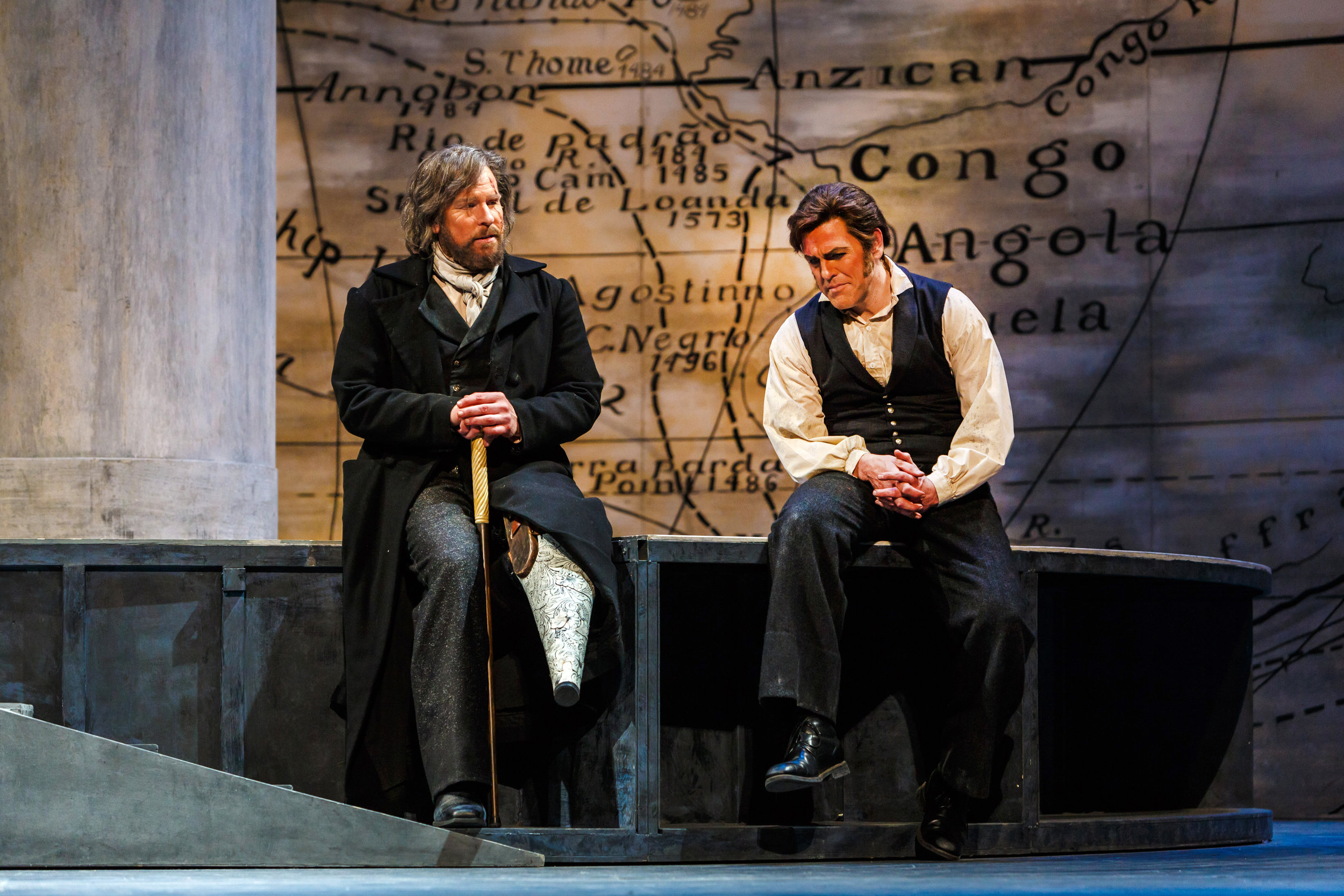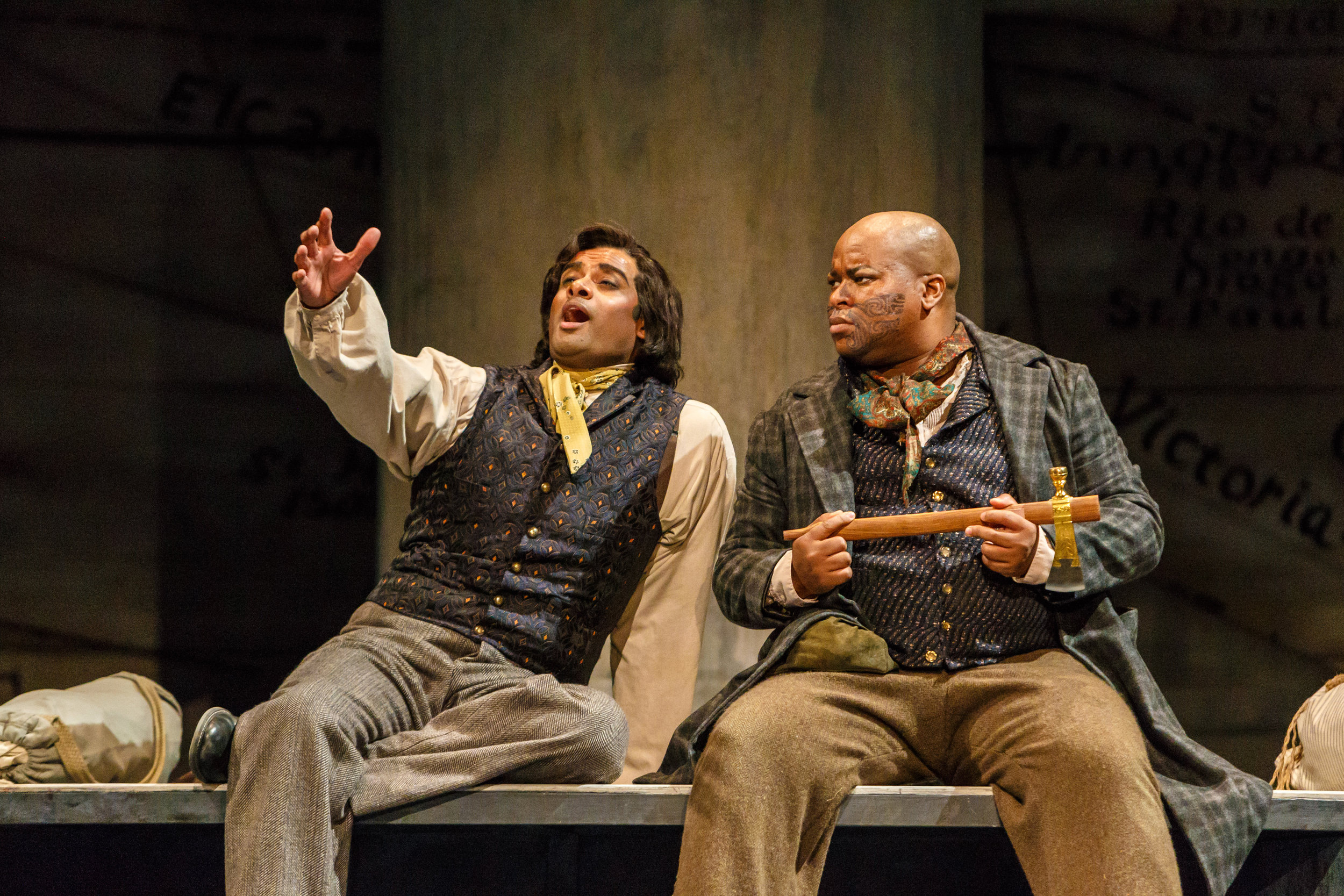Pittsburgh Opera logo; courtesy of Pittsburg Opera.
The audience at the March 20 performance of Pittsburgh Opera’s Moby Dick seemed noticeably younger on average than typically seen at operas these days. I was especially delighted to spot several mother-young daughter combinations in the crowd. I think Moby Dick is okay for most kids who are old enough to sit through a three-hour show including intermission. I wonder if the parent-child pairs had read the book already; it is highly recommended for school book reports. In fact, “Moby Dick” is a literary meme. Few of us have not heard of the book, but few have read it and still fewer finished this titanic novel; I admit to not having read it. How likely is it that those daughters went home happy and perhaps moved by an artistic experience? Is it a good story? A good opera? A good show? Let’s deal with those questions.
Roger Honeywell as Captain Ahab offers a gold doubloon for the man who first spots the white whale, Moby Dick. Photo by David Bachman Photography; courtesy of Pittsburgh Opera.
The first thing my wife noticed about Moby Dick (composer Jake Heggie and librettist Gene Scheer) was how melodic and enjoyable the music is. I agree completely; if Disney makes an animated version, the score will delight that audience as well, much like the classical music in “Fantasia”; It is music you would enjoy listening to at home. The centrality of the music makes conductor Antony Walker and the Pittsburgh Opera Orchestra central players in this opera. The music from the very opening notes sets the mood for an opera where strong undercurrents are directing character’s actions. The music moves the story forward and aids in telling the story, such as the tumultuous prelude starting in Act 2 that will not let the audience forget how Act 1 ended. This is important for newcomers to opera to understand because many opera goers fear modern opera will be abstract, harsh and often dissonant. That is not Jake Heggie’s music. I have seen Dead Man Walking by Heggie as well as Moby Dick, and operas by composer Heggie should serve as the antidote for that fear. Personally, I very much look forward to seeing other operas by Mr. Heggie and even hope to see Moby Dick again in other venues.
left: Roger Honeywell as Ahab and Michael Mayes as Starbuck. right: Sean Panikkar as Greenhorn and Musa Ngqungwana as Queequeg. Photos by David Bachman Photography; courtesy of Pittsburgh Opera.
The four major characters of the novel are those in the opera: obsessed Captain Ahab, idealistic first mate Starbuck, the new to whaling and lonely Greenhorn (Ishmael in the book), and the pagan harpoonist Queequeg are played by four excellent singers, tenor Roger Honeywell, baritone Michael Mayes, tenor Sean Panikkar, and bass-baritone, Musa Ngqungwana. There are also a host of capable supporting role singers, including the opera’s only female role, a pants role for the young boy Pip, played with stirring emotion by soprano Jacqueline Echols. Baritone Malcolm MacKenzie’s cheery spirit as Stubb added a needed counter point to his serious colleagues. As I listened to Mr. Honeywell I was reminded of tenors singing Siegfried in Wagner’s The Ring due to its style. I had previously seen Mr. Mayes in Washington National Opera’s Dead Man Walking; I think he might be even more impressive as Starbuck. This was my first introduction to Mr. Ngqungwana; he has a beautiful bass-baritone and enormous stage presence. But my favorite of the evening was Mr. Panikkar, certainly an opera star in the making. His tenor voice is capable of embellishing lyrics with lovely emotional color. I first remarked on his notable abilities in my blog report on Pittsburgh Opera’s The Summer King from last season. As good as the main role players are, they are almost overshadowed by an outstanding all male chorus led by Mark Trawka. Excellent arias by the major characters, some quite beautiful and touching, are spaced within and supported with gorgeous choral and ensemble singing. Some of the choral numbers reminded me of another Wagner opera, The Flying Dutchman.
The crew of the Pequod prepares for the final chase. Photo by David Bachman Photography; courtesy of Pittsburgh Opera.
There is no question that the story of “Moby Dick” with its unforgettable characters is first rate material for an opera. The quest of a crazed sea captain obsessed with capturing the white whale, Moby Dick, who once caused the loss of his left leg and his ability to draw his crew into his obsession is as gripping as they come; though while apparently seeking revenge, he is in reality seeking a rematch with God. The struggle of Ahab with God and his own humanity, Starbuck’s confrontation with Ahab and his own internal conflicts, Greenhorn’s attempt to outrun his dark outlook, the “savage” Queequeg’s display of true Christian character, and the evolving relationships between these men all add emotional depth to the story. You will care about them; even Ahab, in singing with Starbuck about missing their families, shows am embraceable side. There are reasons why Herman Melville’s novel “Moby Dick” endures and the important elements expressing those themes have been captured by Mr. Scheer’s libretto and undergirded by Heggie’s expressive music.
Moby Dick was presented to strong audience responses beginning with the Dallas opera premiere production in 2010 and a handful of performances in a few other cities. It’s recurrence then dropped off, reportedly due to the cost of staging an elaborate production. How do you portray a whaling voyage and fight with an enormous whale on an opera stage with limited space and resources? As opposed to the movies, media effects can only get you so far. By necessity, sets must to some degree be clever abstractions that suggest and enhance the story when it can’t be presented graphically. The audience’s willingness to suspend disbelief must be engaged. Director Kristine McIntyre led the development of this new production of Moby Dick, supported initially by Utah Opera and Pittsburgh opera; it had its first performances in Utah in January. The San Jose Opera, Chicago Opera and Barcelona’s Teatre Liceu also added support and will be mounting their own performances in the coming months. Ms. McIntyre will be there to stage each. A goal was to increase access to a great opera by developing a production that even regional opera companies can afford.
left: First Mate Starbuck's whale boat on the hunt with Michael Mayes as Starbuck. right: Musa Ngqungwanaas Queequeg comforts Jacqueline Echols as Pip while Sean Panikkar as Greenhorn looks on. Photos by David Bachman Photography; courtesy of Pittsburgh Opera.
Director McIntyre says she read the novel seven times as preparation for taking on this enormous challenge. Pause. She read a 700-page novel seven times; that is demonstrating commitment to your art! One might tease whether it became her own white whale, though she managed to achieved a victory. She is certainly tuned in to the intertwining themes of the novel: the healing nature of friendships, the man-God relationship, indecision in a crisis, dark forces that drive us, complicated or assisted by the good forces that drive us, and soul searching when our beliefs and views are challenged. In the staging Moby Dick, she knew that the opera needed room for big things, for movement of the sea, the vessels, and the whale, to show scenes off the ship Pequod, and the destructive finale. The music is cinematic and the libretto somewhat abstract, needing fleshing out. She and set designer Erhard Rom came up with a constant scene of a circular nautical map with a large mast in the center that gives one a sense of being in the keel of a ship with horizon revealing openings higher up in the map; a center section revolves to allow the smaller whale chasing vessels to be a focus. The expanse of the map gives you a feeling of the open sea while at the same time the curve gives you a sense of being in the keel of a boat. It is all very clever and creative. So much so that I am loathe to offer criticism, but I will offer comment. The denouement lacks the impact that a more graphic depiction of the fight might elicit, and if Queequeg’s coffin could be made to appear floating, that too might add to the illusion. I learned from Director McIntyre just how totally involved in the production a director and conductor are. She was involved in everything including musical decisions and Maestro Walker was also involved in the staging. It was a significant advantage and to our benefit that they have worked together many times in the past. This team would augur well for any production.
An additional feature adding movement as scene enhancement was the choreography, originally by Daniel Charon and transferred to this production by Natalie Desch. Photo by David Bachman Photography; courtesy of Pittsburgh Opera.
In the end, was it a good story? Check. A good opera? Check. A good show? Also check. I will add that it also connects many of us to our past when we struggled with the decision whether to read the book or not and as parents to encourage our children to do so. When asked what she hoped the audience would take away, Director McIntyre said, “We hope they will be entertained of course, but also moved; that they will understand that behind the mayhem with Ahab, Starbuck, Greenhorn, Queequeg, and others lie journeys of self-discovery. And, maybe that the novel will seem less intimidating.”
The Fan Experience:
There remain two performances of Moby Dick in Pittsburgh, Friday evening, March 23 and a Sunday matinee, March 25 . Tickets remain in all price ranges, including specially priced tickets for students.
This opera offers the junior high school through college demographic a chance to view a classic story and give opera a try at the same time. Future venues ought to offer a special lower price performance for parents attending with their kids; just a feeling – I know nothing about marketing, but it was so charming seeing the parent-child pairs in the audience at a modern opera.








